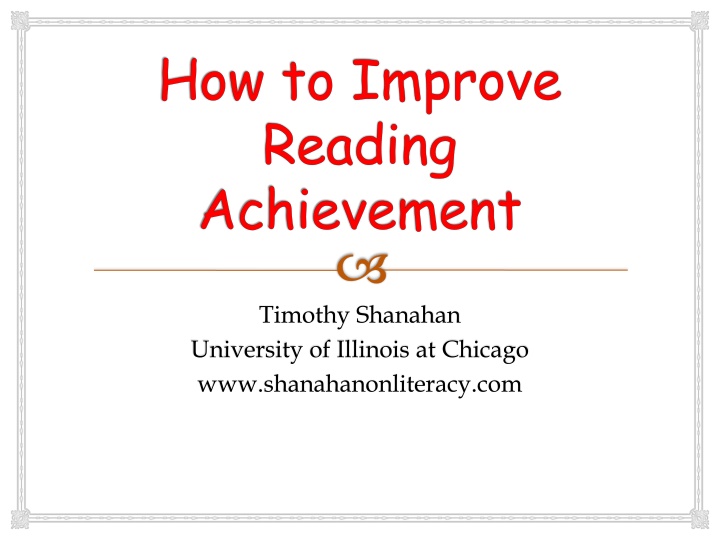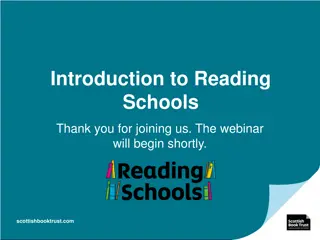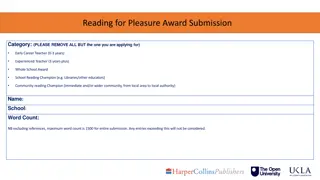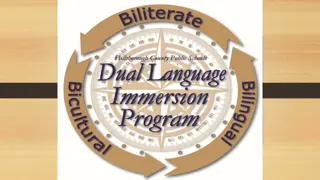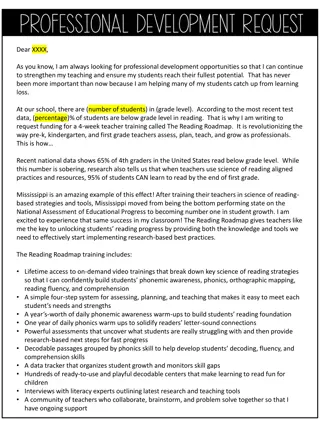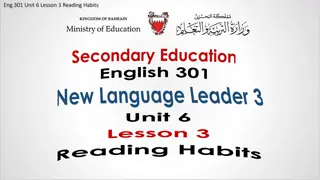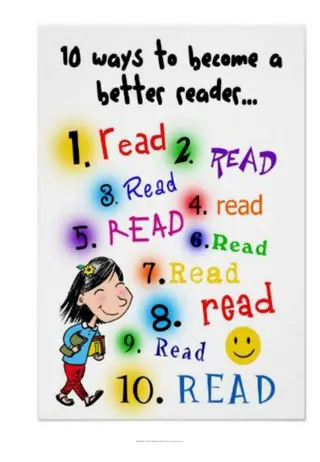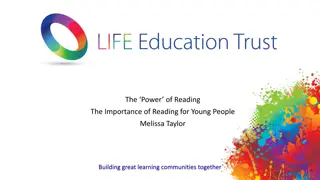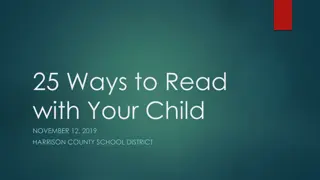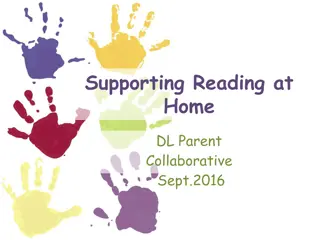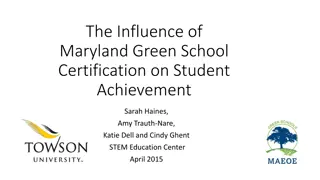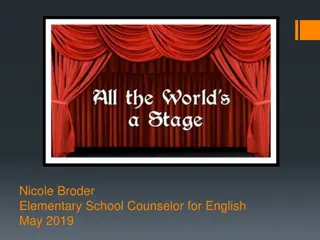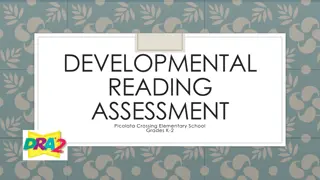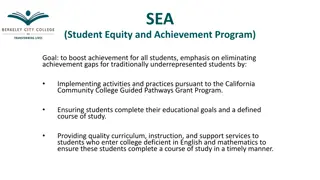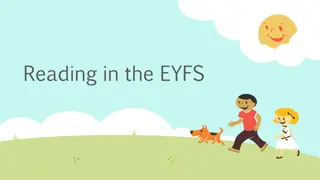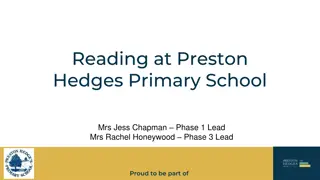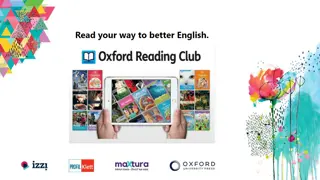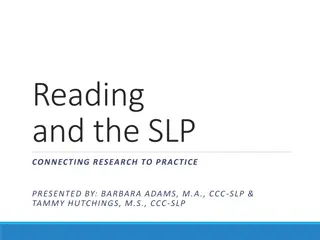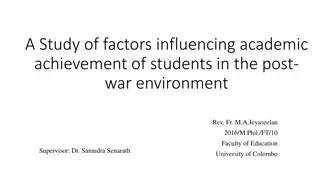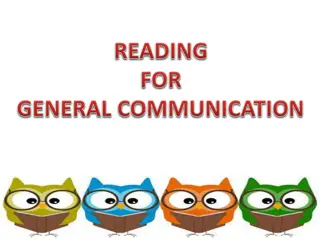Improving Reading Achievement: Factors and Impact
Key factors influencing reading achievement, including the amount of instructional time, disparities in early vocabulary experience, effects of full-day kindergarten, and extended school year benefits. Discover how academic experience plays a crucial role in children's progress in reading.
Uploaded on Apr 16, 2025 | 1 Views
Download Presentation

Please find below an Image/Link to download the presentation.
The content on the website is provided AS IS for your information and personal use only. It may not be sold, licensed, or shared on other websites without obtaining consent from the author.If you encounter any issues during the download, it is possible that the publisher has removed the file from their server.
You are allowed to download the files provided on this website for personal or commercial use, subject to the condition that they are used lawfully. All files are the property of their respective owners.
The content on the website is provided AS IS for your information and personal use only. It may not be sold, licensed, or shared on other websites without obtaining consent from the author.
E N D
Presentation Transcript
How to Improve Reading Achievement Timothy Shanahan University of Illinois at Chicago www.shanahanonliteracy.com
So what matters? Children s experience
Experience Amount of experience Content of experience Quality of experience
Amount of Instruction Amount of teaching or academic experience is the most important factor in children s reading achievement Children with the most academic experience make the most progress in reading and as instructional time increases learning tends to go up too
Disparities in Early Vocabulary Experience 30 million word gap Professional Families 1200 Child s Cumulative Vocabulary Working Class Families 600 (Words) Welfare Families 200 16 mos. 24 mos. 36 mos. Child s Age (Months) Source: Hart & Risley (2003)
Effects of full-day kindergarten Full-day kindergarten increases academic experience by about one month per year Full-day kindergartens consistently outscore half-day kindergartens Full-day kindergarten has stronger, longer lasting benefits for children from low-income families or others with fewer educational resources prior to kindergarten
Number of Instructional Days in School Year by Country 250 International Average = 193 School Days/Year 230 225 223 221 210 196 195 191 190 188 190 180 170 150 Korea Japan China Australia Russian Federation Netherlands England Canada UNITED STATES SOURCE: Trends in International Mathematics and Science Study (TIMSS) 2003
Extended school year In a study in Chicago, extending the school year by 30 days led to increases in student learning in reading and math (Frazier & Morrison, 1998) This study increased kindergarten by 30 days and raised reading achievement by about 1 full year in reading over comparison children
Use of School Day Concept of Academic Learning Time (Fisher, Marliave, Filby, 1978) Beat the odds comparison showed that effective teachers in grades K-3 keep students on task/engaged 96% of the time, students of less effective teachers only 63% (Taylor, 1999, 2006). Bell to bell teaching (Mel Riddle)
Kennewick School Annual Growth for All Students Catch-up Growth for Those Who are Behind by Lynn Fielding, Nancy Kerr, and Paul Rosier Tells of experiences in Kennewick, WA school that successfully raised reading achievement They estimate that 60-80 minutes of reading instruction (per day/per year) will raise achievement one year So, a youngster who enters 3rd grade 2 years behind in reading, will need about 240 minutes of instruction daily to catch up
Washington Elementary School Growth in % of 3rd grade students meeting grade level standards School Year 95 96 97 98 99 00 01 02 03 04 05 06 Percent at Grade level 57 72 72 68 78 94 96 99 94 9899 98 Began providing intensive interventions in the afternoon to many students Working harder and more effectively at 3rd grade Result of improvement at both 2nd and 3rd Grade Baseline year Began testing in 2nd grade and focusing on earlier improvement
Other data on amount of instruction Preschool Reading First Absenteeism After-school programs Summer school programs Summer reading Snow days Days with unplanned teacher absences
What to do? Protect children s reading time Be vigilant about lost time Seek ways to increase academic time within and beyond the school day/year Never do in small group what could have been done as well in whole class; never do individually what can be done as well in small group (grouping has clear benefits, but it also has costs) Multi-tier support needs to be more protective of learning time
Curriculum What we teach matters One of the great research findings is that students tend to learn what is taught (Walker & Schefarzik, 1967) Research finds curriculum to be the second most important influencer of learning (though this is a bit of an intellectual trick)
Curriculum We don t know exactly what needs to be taught There are always examples of children who made good progress without any instruction in particular aspects of reading However, there is content that consistently shows benefits for the group Essential that we give students every opportunity to learn all of the components of reading that make a learning difference
Phonological Awareness PA ability detect, manipulate, or analyze the auditory aspects of spoken language independent of meaning (e.g., word separations, syllables, rhymes, phonemes) Individuals who can fully segment words do better in reading than those who cannot Research has found PA to be a good predictor of later reading achievement (especially of decoding) Research shows that it is possible to teach children to hear and manipulate the sounds of language in preschool, kindergarten, and grade 1 (and older readers who struggle with this skill)
Phonological Awareness PA is a continuum learners go from grosser to finer sounds with the end point being full segmentation PA instruction has larger effect sizes in normal classroom studies than in studies of reading disabled children Rhyming has the weakest effects of the PA skills PA instruction is most effective when it is kept simple and when it is combined with letter name training
Phonological Awareness By kindergarten, kids usually need only about 14-18 hours of phonemic awareness training Instruction was usually individual or small group
Decoding Decoding refers to knowledge of letters, letter sounds, and spelling patterns and the ability to use this knowledge to figure out the pronunciation of printed words Research finds Decoding instruction to be effective in K, Grades 1 and 2, and with older struggling readers (but the biggest payoffs are early on) Decoding instruction found to improve reading of nonwords and words, oral reading fluency, spelling and reading comprehension with younger readers and word reading and fluency with older struggling readers
Decoding Systematic phonics instruction better than no phonics instruction or diagnostic phonics Multiple years of phonics training best Most successful instruction was delivered to individuals or small groups Importance of a quiet classroom during decoding instruction No single program had enough research to recommend a program, though all worked to some extent Include decoding and encoding practice
Vocabulary Vocabulary refers to knowledge of the meanings and meaningful parts of words Explicit vocabulary teaching improves reading comprehension Effective vocabulary instruction focuses on words that are common in text, but not common in oral language, and such instruction emphasizes depth of meaning, relationships among words, vocabulary use, and review Teaching of morphology is beneficial, too
Oral Reading Fluency Oral reading fluency refers to the ability to read text accurately, with sufficient speed, and prosody Oral reading fluency instruction improves word reading, fluency, and reading comprehension (oral and silent) Oral reading fluency is developmental: initially accuracy is especially important, then speed develops, and later prosody becomes important
Oral Reading Fluency Fluency instruction has been found to be important (improved comprehension) in grades 1-4, and with remedial readers in grades 1-12 Impact of fluency teaching was equal for regular classroom instruction and with reading disabled students Correlational studies show that the importance of fluency declines across the years, but that even by Grade 8 fluency differences explain 25% of the variation in reading comprehension
Oral Reading Fluency Effective fluency instruction focuses on relatively difficult text It emphasizes oral reading, feedback, modeling, repetition There are now some computer-driven silent reading programs that seem to be effective Instructional options: paired reading, partner reading, repeated reading, echo reading, neurological impress, etc.
Reading Comprehension Reading comprehension is a process in which the reader constructs meaning from the information included in the text and the reader s knowledge Comprehension strategy instruction improves reading achievement Summarization, questioning, monitoring, visualization, text structure, inferencing, and prior knowledge use were all effective comprehension strategies Strategy instruction was effective across a wide range of grade levels and with both average and disabled readers
Reading Comprehension Gradual release of responsibility approaches were effective for teaching reading comprehension Teaching question types is not an effective way of teaching reading comprehension But prior knowledge matters in reading comprehension and it is critical that we use reading to build knowledge Even good strategy instruction will place a heavy emphasis on content
No performance differences due to question types (skills)
No performance differences due to question types (cont.)
Writing Research shows a close relationship between reading and writing Lots of skill and strategy overlap, and yet, reading and writing are independent If they were not, then you would only need to teach one or the other However, the overlap is what allows the cross-linguistic teaching to pay off Graham & Hebert (2010): Meta-analyses of experimental studies show that writing about text can have a powerful impact on writing and reading achievement
Some key research results from writing about text 93% of study outcomes in which students wrote about text showed positive impacts (grades 2-12) There were better effects for the good writers, but when students were explicitly taught how to write (not just assigned writing), then these impacts were equally large for poor readers Writing about text was more powerful than just reading, or reading/rereading/studying text, or discussing text
Other Possibilities Oral language Content information (domain knowledge, knowledge of the world)
Quality Quality is hard to define (harder to measure) I define it negatively: any feature of instruction associated with learning that is not mediated by amount or curriculum Basically, if two groups receive the same amount of instruction/practice with the same content then differences in learning are due to qualitative differences
Quality Explicit Teaching Modeling Guided practice Collaborative use Independent practice Review
Quality Clear purposes of lessons Students should know what they are doing and what they are trying to learn
Quality Opportunities for response and interaction With teachers With students Engagement Language practice
Quality Clear explanations
Quality Reading/writing within instruction More is better
Summary More is better than less PA, phonics, oral reading fluency, vocabulary, comprehension Need high quality instruction Important to align supervision, professional development, instructional materials, assessments, and parent support with this framework
